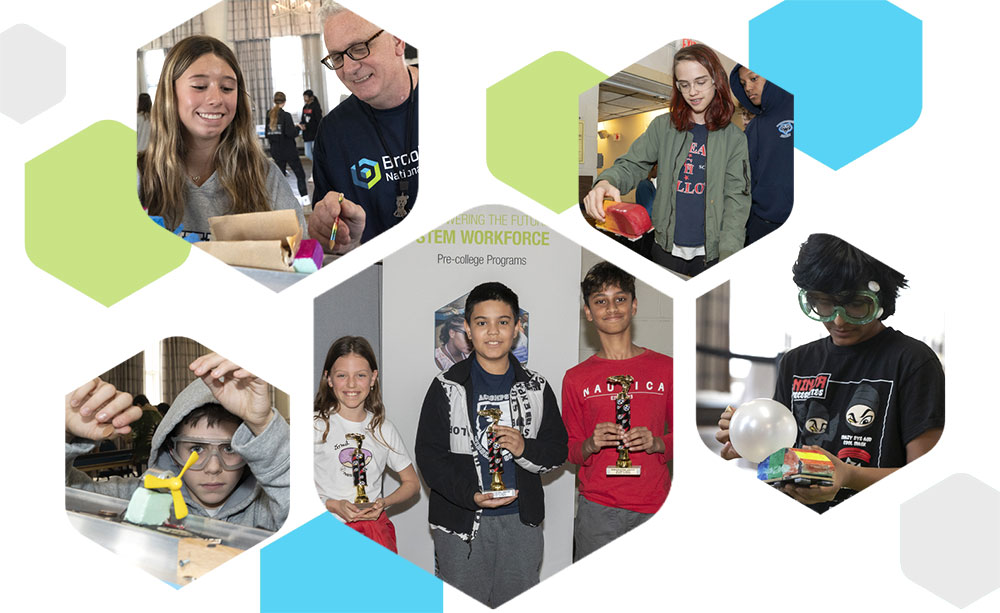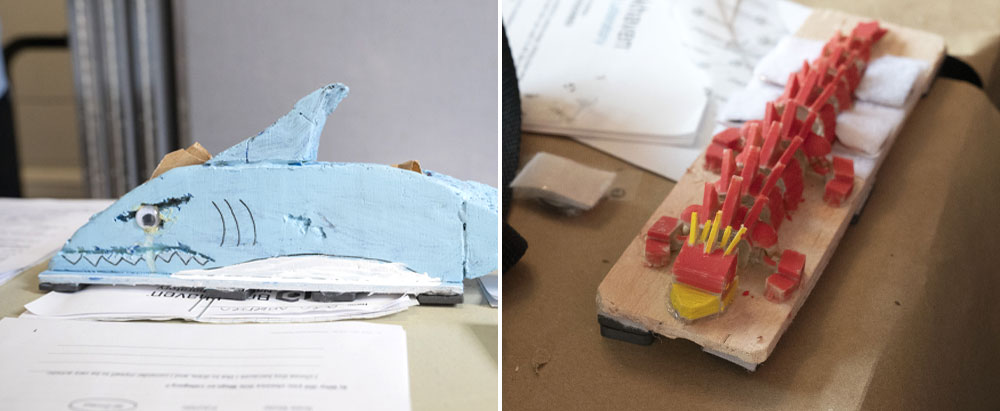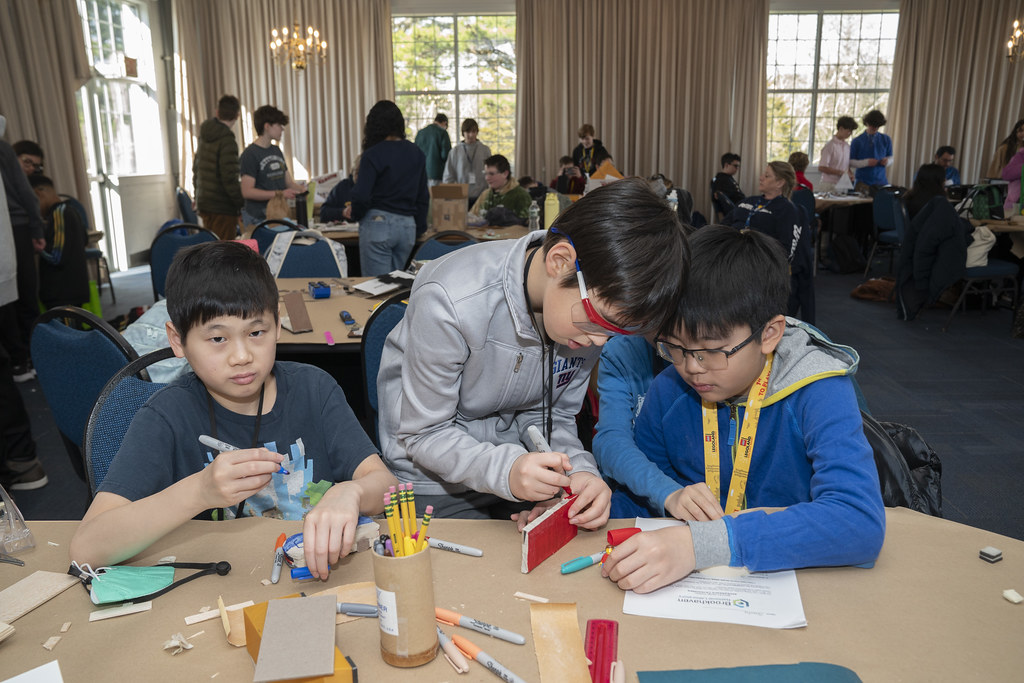Long Island Students Compete at Brookhaven Lab's Maglev Contest
Students use STEM and problem-solving skills to aim for top honors in vehicle speed and appearance
March 27, 2024

Students use math, science, and technology principles to optimize the design of their maglev creations. (Jessica Rotkiewicz/Brookhaven National Laboratory)
UPTON, N.Y. — A big blue shark, an array of pirate ships, and a propeller-driven water bottle were among student-made magnetic levitation vehicles that floated down the tracks at the 2024 Maglev Competition hosted by the U.S. Department of Energy’s Brookhaven National Laboratory on March 20.
Students from middle schools across Long Island became engineers at the annual contest, designing and refining their maglev creations to log their fastest travel time. A total of 150 students from 10 local middle schools submitted vehicles in hopes of earning top spots in eight categories judging speed and appearance.
The competition is inspired by technology pioneered by two Brookhaven Lab researchers, the late Gordon Danby and James Powell, who invented and patented superconducting maglev — the suspension, guidance, and propulsion of vehicles by magnetic forces.
“The Maglev Contest is unique in the way it provides students with an open environment to tinker, tweak, and test their vehicle designs in order to achieve the best possible outcome,” said competition coordinator Jonathan Ullmann, a senior education programs representative for the Lab’s Office of Educational Programs. “This process is very similar to how the scientists and engineers work on big research projects here at Brookhaven Lab.”
During the awards ceremony, the students heard from Robert Caradonna, a federal project manager at the DOE-Brookhaven Site Office, about his role in overseeing large design and construction of scientific research facilities including the current project to construct the Electron-Ion Collider (EIC) — a new discovery machine that physicists will use to explore the building blocks of matter — and the previous effort to construct the National Synchrotron Light Source II (NSLS-II), a DOE Office of Science user facility where interdisciplinary researchers explore materials.
Students use math, science, and technology principles to optimize the design of their vehicles. The competition day also brings out their creativity and resourcefulness on the fly: one student fixed their math homework to their vehicle to use as a sail on the contest’s wind-powered track; another student attempted to fill a disposable glove with air to propel their vehicle down a flat track after their original balloon broke.
“That’s what it’s all about — for them to troubleshoot and figure it out,” said David Driscoll, a technology teacher at Albert G. Prodell Middle School. “They’re learning to have patience, think through things, change things up, and make adjustments.”
Students who opted to compete in this year’s appearance categories went for unique and eye-catching designs that included a leek (the vegetable) used as a vehicle body, hand-painted artwork from a favorite show, and color-changing lights. A host of 3D-printed creations traveled down the tracks, too, including train cars, a racecar, and an intricate lizard.
This was the first year that the Bridgehampton School’s STEAM Team — a before-school club — entered 3D-printed vehicles into the competition after learning how to use 3D printers and a modeling program.
“We’ve been using MakerBot 3D printers and Tinkercad; the kids have been having a blast on it,” said Lou Liberatore, a fifth-grade teacher at Bridgehampton.
Mallory Dougherty, also a fifth-grade teacher at Bridgehampton, added: “We’re really excited to be in that category. They really picked up on it. They impressed us with how they were about to figure out how it all works.”
See more photos from the competition and awards ceremony. Hover over image to reveal slideshow controls. (Jessica Rotkiewicz/Brookhaven National Laboratory)
Speed categories
Self-propelled (balloon)
- First place: Andrew Oliveri, Bay Shore Middle School
- Second place: Ghaleb Rashid, Bay Shore Middle School
- Third place: Landon Wernersbach, Bay Shore Middle School
Self-propelled (other)
- First place: Owen Huber, Bay Shore Middle School
- Second place: Caleb Leichtman, Bay Shore Middle School
- Third place: Indigo O'Neill, Bay Shore Middle School
Electrified track
- First place: Chase Harrison, Bay Shore Middle School
- Second place: Jordan Patron, Bay Shore Middle School
- Third place: Ethan Rodriguez, Bay Shore Middle School
Wind power
- First place: Jordyn Lusak, Albert G. Prodell Middle School
- Second place: Brody Morgan, Great Hollow Middle School
- Third place: Alex Manessis, Accompsett Middle School
Gravity
- First place: Jonah Maraglio, Albert G. Prodell Middle School
- Second place: Eva Cabrera, Bay Shore Middle School
- Third place: Doris Lu, Great Neck South Middle School
Appearance categories
Futuristic
- First place: Aylin Tucksonmez, Albert G. Prodell Middle School
- Second place: Jeremy Schember, Great Hollow Middle School
- Third place: Alexander Radek, Great Hollow Middle School
Scale model
- First place: Quentin Lennox, Marcus Chang, & Lucas Chang, Great Neck South Middle School
- Second place: Owen Anderson, Albert G. Prodell Middle School
- Third place: Brendan D'Agostino, Berner Middle School
3D printed
- First place: Srihas Mandava, Accompsett Middle School
- Second place: Landon Tully, Accompsett Middle School
- Third place: Stella Bond, Bridgehampton School
Brookhaven National Laboratory is supported by the Office of Science of the U.S. Department of Energy. The Office of Science is the single largest supporter of basic research in the physical sciences in the United States and is working to address some of the most pressing challenges of our time. For more information, visit science.energy.gov.
Follow @BrookhavenLab on social media. Find us on Instagram, LinkedIn, X, and Facebook.
2024-21765 | INT/EXT | Newsroom











